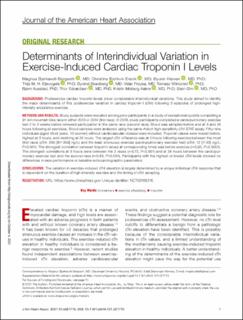| dc.contributor.author | Bjørkavoll-Bergseth, Magnus | |
| dc.contributor.author | Erevik, Christine Bjørkvik | |
| dc.contributor.author | Kleiven, Øyunn | |
| dc.contributor.author | Eijsvogels, Thijs M. H. | |
| dc.contributor.author | Skadberg, Øyvind | |
| dc.contributor.author | Frøysa, Vidar | |
| dc.contributor.author | Wiktorski, Tomasz | |
| dc.contributor.author | Auestad, Bjørn | |
| dc.contributor.author | Edvardsen, Thor | |
| dc.contributor.author | Aakre, Kristin Moberg | |
| dc.contributor.author | Ørn, Stein | |
| dc.date.accessioned | 2021-10-06T08:43:37Z | |
| dc.date.available | 2021-10-06T08:43:37Z | |
| dc.date.created | 2021-10-04T10:43:36Z | |
| dc.date.issued | 2021 | |
| dc.identifier.issn | 2047-9980 | |
| dc.identifier.uri | https://hdl.handle.net/11250/2788018 | |
| dc.description.abstract | Background: Postexercise cardiac troponin levels show considerable interindividual variations. This study aimed to identify the major determinants of this postexercise variation in cardiac troponin I (cTnI) following 3 episodes of prolonged high‐intensity endurance exercise.
Methods and Results: Study subjects were recruited among prior participants in a study of recreational cyclists completing a 91‐km mountain bike race in either 2013 or 2014 (first race). In 2018, study participants completed a cardiopulmonary exercise test 2 to 3 weeks before renewed participation in the same race (second race). Blood was sampled before and at 3 and 24 hours following all exercises. Blood samples were analyzed using the same Abbot high‐sensitivity cTnI STAT assay. Fifty‐nine individuals (aged 50±9 years, 13 women) without cardiovascular disease were included. Troponin values were lowest before, highest at 3 hours, and declining at 24 hours. The largest cTnI difference was at 3 hours following exercise between the most (first race) (cTnI: 200 [87–300] ng/L) and the least strenuous exercise (cardiopulmonary exercise test) (cTnI: 12 [7–23] ng/L; P<0.001). The strongest correlation between troponin values at corresponding times was before exercise (r=0.92, P<0.0001). The strongest correlations at 3 hours were between the 2 races (r=0.72, P<0.001) and at 24 hours between the cardiopulmonary exercise test and the second race (r=0.83, P<0.001). Participants with the highest or lowest cTnI levels showed no differences in race performance or baseline echocardiographic parameters.
Conclusions: The variation in exercise‐induced cTnI elevation is largely determined by a unique individual cTnI response that is dependent on the duration of high‐intensity exercise and the timing of cTnI sampling. | en_US |
| dc.language.iso | eng | en_US |
| dc.publisher | Wiley | en_US |
| dc.rights | Attribution-NonCommercial-NoDerivatives 4.0 Internasjonal | * |
| dc.rights.uri | http://creativecommons.org/licenses/by-nc-nd/4.0/deed.no | * |
| dc.title | Determinants of interindividual variation in exercise-induced cardiac troponin I levels | en_US |
| dc.type | Journal article | en_US |
| dc.type | Peer reviewed | en_US |
| dc.description.version | publishedVersion | en_US |
| dc.rights.holder | Copyright 2021 the authors | en_US |
| dc.source.articlenumber | e021710 | en_US |
| cristin.ispublished | true | |
| cristin.fulltext | original | |
| cristin.qualitycode | 1 | |
| dc.identifier.doi | 10.1161/JAHA.121.021710 | |
| dc.identifier.cristin | 1942930 | |
| dc.source.journal | Journal of the American Heart Association (JAHA) | en_US |
| dc.identifier.citation | Journal of the American Heart Association (JAHA). 2021, 10 (17), e021710. | en_US |
| dc.source.volume | 10 | en_US |
| dc.source.issue | 17 | en_US |

